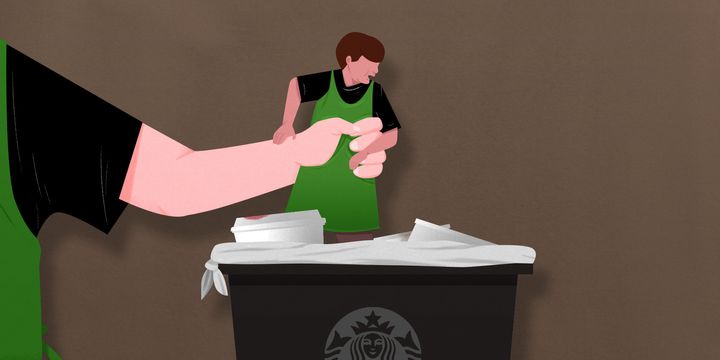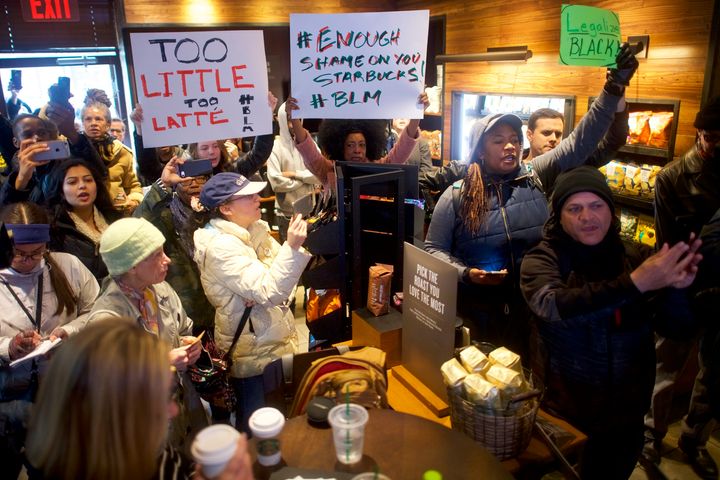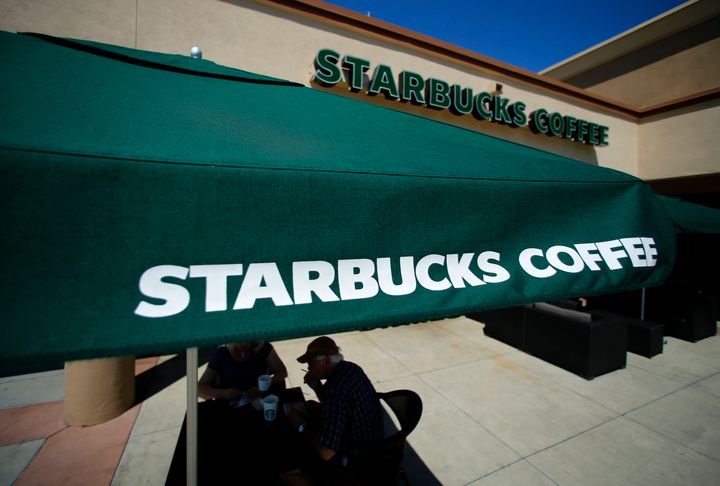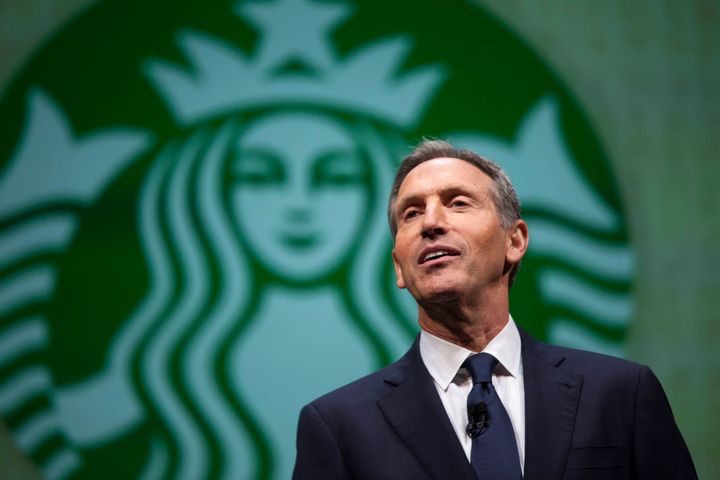
Andrea spent a recent 13-hour shift at Starbucks, where she works as a manager, in agony. The 52-year-old, who asked that her real name and location not appear in this story for fear of losing her job, had opened the store at 5:15 a.m. and was supposed to leave at 1:45 p.m. But then she had to cover for an employee who went home sick.
An hour into her shift, she started to feel the familiar sharp sensation that shoots up from her feet to her back whenever she stands for prolonged periods. A few hours later, she began to limp. Andrea has a health condition that she didn’t want to specify, to protect her anonymity. She ignored the severe pain as she took drive-thru orders and made sure the coffee bar was running smoothly.
In the past four years, Andrea has applied for 29 jobs within Starbucks, in areas like human resources and recruiting, that would allow her to spend less time on her feet. She’s been rejected from all of them, and only once landed an interview, even though she’s been with the company for 15 years, was voted manager of the quarter for her district in 2016 and earned a degree through the Starbucks scholarship program at Arizona State University.
At first, Andrea thought she simply needed to further develop her management skills and put in more face time with the regional head office. But over the past two years, as she’s watched several of her colleagues over age 40 be fired or suddenly leave the company, she’s begun to suspect a more sinister reason for her repeated rejections.
Every time she receives the same corporate rejection letter stating that they decided to “go in another direction,” she thinks: “Am I a liability to them at this point with my health or with my age?”
Andrea’s started to feel like her days at the company are numbered.
Though she’s taken time off to have multiple surgeries, she never complains about her pain at work, worried that doing so could get her fired.
“I’m scared going to work every day that they are going to find some reason to let me go,” she told HuffPost. While her annual salary of around $71,000 is high for a service industry job, she’s a single mom who still lives paycheck to paycheck, supporting herself and her 23-year-old daughter who lives at home and has a neurological condition. Andrea estimates she spends between $200 and $400 a month on their medical expenses. “I would go bankrupt in less than six months, I can tell you that.”

Starbucks has recently been in the headlines for requiring its staff to undergo racial bias training, after two black men were arrested at a Philadelphia store in April while waiting for a friend. But some employees say there’s another bias the company needs to address: age discrimination.
HuffPost spoke with seven current and former managers of Starbucks-owned stores in five states who say they were bullied by management and, in most cases, were either fired or pushed out of the company for being over age 40.
While Starbucks is often held up as a enviable workplace, where employees are called “partners” and receive stock options, a generous benefits package and free online college tuition, older staff members say the company is increasingly treating employees as disposable. They say that in the past five years, Starbucks has seemed intent on replacing older managers with younger, lower-paid workers who will tough out long shifts, take on greater workloads and cost less to insure.
Most of the people HuffPost interviewed had worked at the company for more than 10 years, and described similar patterns of being unfairly criticized at work, passed over for promotions, given fewer responsibilities over time and ultimately being forced out or let go for reasons that were at odds with their high performance. The situations range from an employee who said her manager made age-related comments to others who said managers fixated on their injuries, attacked their work and ostracized them.
Several said they complained to human resources, but that internal investigations were not done thoroughly and resulted in no apparent consequences for discriminatory managers.
“We have zero tolerance for any sort of harassment of any kind and have a very clear set of guidelines when any type of harassment or discrimination claims like this are made,” said Reggie Borges, a spokesman for Starbucks, adding that the company can’t comment on specific cases. “We want our stores to be a welcoming environment for our partners and our customers and in any instance where that is not the case, we want to take swift action and address it.”
One employee told HuffPost she’s filed a complaint with the federal Equal Employment Opportunity Commission, alleging she was fired because of age discrimination, and says she plans to pursue a lawsuit if the company doesn’t agree to mediation. Another former employee, Diana Kelly, recently hired a lawyer and plans to file an EEOC complaint for wrongful termination based on ageism.
The company has faced accusations of age-related discrimination before. In 2013, a 65-year-old former barista filed a complaint with the Maryland Commission on Civil Rights after she was fired and replaced with two workers in their 20s. Starbucks told the community news site Gazette.net there was “no factual basis” to the woman’s claims. In 2015, a 63-year-old former Starbucks manager sued the company for wrongful termination based on ageism. The company settled.
“The biggest betrayal is ‘respect and dignity to every partner,’” said Kelly, paraphrasing part of the company’s mission statement. “I don’t feel like that has turned out to be true for the older people.”
‘One down, three to go’
Candice, a 42-year-old former Starbucks store manager in Orlando, Florida, filed a complaint with the EEOC after she was fired in March. Candice asked that HuffPost not publish her last name, to avoid jeopardizing her current job search.
She says she injured her back on the job last May, carrying 20 pounds or so of coffee. She took a brief medical leave, and when she stopped by the store almost two weeks after the injury, Candice’s boss handed her a “corrective action,” a document that listed issues with her performance. Her manager claimed she had failed to properly fill out the shift schedule ― though Candice said she hadn’t been informed of a new protocol ― and the cleaning schedule. Candice says she kept diligent cleaning records, which her manager had not audited or signed for over three months, despite protocol that her boss do so at least every six weeks. (HuffPost reviewed the cleaning logs in question, and it does appear that her boss had not signed them for several months.)

Candice, who worked for the company during two different periods for a total of eight years, was shocked to receive the corrective action, which she says is usually reserved for employees on the path to being fired. Her manager had never given her a verbal warning, which she says is usually the first step for low-level performance issues. (Borges said the type of corrective action an employee receives ― verbal, written or final ― depends on “the severity and nature of the infraction.”) Candice ran a high-earning store, had recently been cited by senior management as an exemplary leader in an email to all stores in the Florida region, and was beloved by many of her customers and employees. In an email to human resources that HuffPost reviewed, one colleague described Candice as a “mentor” and “the best Starbucks Manager I have ever had.”
Candice was so panicked about the prospect of being fired from a job she loved, and losing the salary her family of five depended on, that she lied to her doctor about feeling better and cut her medical leave short.
“I told my husband ‘If I don’t go to work tomorrow, I’m going to lose my job,’” she said. “It never felt like there was a real performance issue or anything out there I had missed. I really felt like I was a target immediately.”
When Candice returned to work, what she now sees as age discrimination became worse. Her district manager, a woman in her early or mid-30s who started the job in 2016, began showing up to the store to complain that it was dirty and disorganized. Candice says that was untrue, and HuffPost reviewed a document that showed her store scored a 96.8 percent on the company’s quality control inspection in June.
Every six weeks, her boss would send out a survey asking employees to rate Candice’s performance, according to a former barista at the store who asked not to be named in this story. The former employee added that it felt like their district manager was trying to “find some reason she could use to fire” Candice.
Candice says her manager also began making comments suggesting she was unfit to manage a store because of her injury and the fact that she was raising three sons. She felt like the comments were due to her age.
“I never thought I was old,” she said. “I worked really hard for 12-hour days and actually felt I had more stamina than 20-year-olds.”
A colleague told Candice that when a woman over 50 from their district was demoted in July, their boss said “One down, three to go” ― a reference to Candice and two other store managers over 40 in their district. (The colleague would not comment for this article because they still work at Starbucks and are concerned about job security, but HuffPost reviewed a text message that confirmed the colleague had reported the comment to an internal investigator.)
Candice felt like she could be fired any day. The stress turned her into a “zombie” who would come home from work and go straight to her room. Her husband said she had anxiety attacks that made her hands shake and her head dizzy. “I felt really bullied and harassed all the time,” Candice said. “[My manager] would always find something to put me down, and I would literally come out of work in tears or extremely sad. She had so much power over me, and it became a fight for my job and a fight for me and my integrity.”
Candice called HR to complain about her boss’ behavior three months after her injury, and says she was told another employee had also complained about this particular district manager. The company conducted an investigation. Candice says the investigator concluded that her boss had made the “One down, three to go” comment, which another employee had verified, and said that the manager “needs coaching on how to address partners” ― but Candice says she didn’t witness any consequences.
In March, Candice was fired after her boss claimed she failed to meet a “performance improvement plan.” Candice says she was replaced with a younger employee.
Covering up ageism
Legal experts say age discrimination in the workplace is common but hard to prove. Walker Harman Jr., a New York-based lawyer who specializes in employment law, says roughly half of his cases involve discrimination based on age or disability. It’s most common in jobs where employees are visible to the public, like in the service or retail industries, and at companies that want to project a young, hip image.
Unlike other forms of discrimination, employers have many ways of masking ageism. “Only infrequently do we get a case where someone has said ‘We gotta get rid of this old man’ or ‘You should retire’ or ‘You’re too old to use a smartphone,’” said Harman. “More often than not, it’s much more subtle and there were no overt statements made. The person was just terminated and replaced with a much younger person.”
Harman says management often invents or exaggerates performance issues to obscure ageism. “[Companies] have all these code of conduct things they have to follow,” he said. “Usually some young boss comes in and does not like working with the older person who has been around forever and finds any way to get rid of them as a technical matter.”
We kept getting more and more work and less and less time.Angela Gustavson, former Starbucks store manager
A soon-to-be-released survey from the AARP found that 61 percent of people over 45 say they have experienced or observed age discrimination at work.
Laurie McCann, a senior attorney for the AARP, said one potential sign of age discrimination is when an older, high-performing employee suddenly gets bad performance reviews. “It seems remarkable that someone was a stellar employee only to become a horrible employee,” she said. “That type of evidence can be helpful.”
Kelly, a former district manager who oversaw 12 Starbucks stores in northern Virginia, found out she had been fired last October. Kelly’s stores consistently ranked in the top five for her region, which she says includes roughly 600 stores, in customer service, low turnover and cleanliness.
The 60-year-old was let go suddenly, after her manager found a two-year-old photo of Kelly and other employees holding unopened bottles of wine at a colleague’s going-away party, which had been held at a Starbucks. Kelly was looking into alcohol-related claims involving other employees when her manager asked if she knew of any other incidents involving alcohol in her district. Kelly couldn’t recall any, but a few days later, her manager showed her the photo.
Kelly hadn’t considered the going-away party a policy violation. For one, she says the wine bottles were gifts that nobody drank at the store. The party was also held at 8 p.m., and though the store was still open, none of the employees who attended the party, including her, were working. (HuffPost reviewed a statement by the colleague the party was celebrating that corroborated those details and also noted that Kelly hadn’t brought any alcohol to the store herself or known that others would be doing so.)
The company policy, which HuffPost reviewed, specifies that alcohol is forbidden “on company premises, while conducting company business or during working time.” Kelly’s understanding was that if an employee wasn’t on company time, they could have a closed bottle of alcohol in a store; in 2016, for example, she was at another going-away party where employees gave a former manager wine without punishment. (A current Starbucks employee corroborated her account of that event, and added that in December, they witnessed a similar situation.) But Kelly says her boss told her that as a district manager, she was “always on the clock.” Borges said the company couldn’t comment on Kelly’s specific case, but that Starbucks’ policy makes it “very clear you are not allowed to have alcohol on company premises, full stop.”
Kelly thinks her boss saw the photo as an excuse to let her go. “I felt like it was a gift, like ‘Wow, we finally have something on her,’” she said, adding that she was the oldest member of her team. “I was on the higher end in terms of pay, and I think that had a lot to do with it.”
While she said she might have handled the going-away party differently in hindsight, she doesn’t think she deserved to be fired for a two-year-old violation of an unclear company rule.
Throughout her career at Starbucks, Kelly says, various bosses had promised her a promotion from district manager to regional manager. She even moved away from her family for six months to work on a project at the company’s support center in Seattle. She says management had told her this would be a steppingstone to higher positions.
But Kelly kept watching that role go to younger employees. In 2012, she says, a senior manager told her an “intangible” might be standing in the way of her getting promoted. She started to suspect her age was the reason when, in 2016, her 34-year-old boss started stripping away her responsibilities, such as training new employees.
Kelly became confident age discrimination was at play last summer, when the regional vice president told her she could not start an official company community group for older Starbucks staff, like the groups that exist for female, black, LGBTQ, veteran and sustainability-minded staff.
Her firing came as a shock. After being let go from a company she had served for 13 years, she “felt totally destroyed and totally betrayed.”
Profit over people
Current and former Starbucks employees told HuffPost they feel age discrimination is the byproduct of a larger company shift from valuing staff to treating them as replaceable worker bees.
In the last five years, Kelly said, the company has focused on programs to streamline duties and specify the exact tasks employees should be doing during their shifts, how long they should take and how often they should be repeated. The company that once had a reputation for putting employees first was now prioritizing efficiency and profit.
“I have never heard the words ‘quality of life’ in so many years now, it’s ridiculous,” said Kelly. “The pendulum has swung from one extreme to the other.”
In 2016, a Starbucks employee in California made headlines after starting a petition on Coworker.org, a platform for grassroots workplace campaigns, about labor issues, which resulted in a number ofarticles about chronic understaffing within the company. The following year, 89 percent of Starbucks workers said staffing was still an issue.

“We kept getting more and more work and less and less time,” said Angela Gustavson, a 53-year-old former store manager in Daytona Beach, Florida, who says she left the company in September for reasons related to age discrimination. “And we still had to be this positive upbeat cheerleader and it was getting really hard.”
Gustavson had the same district manager Candice did, and describes a similar pattern of being unfairly criticized at work in the year before she was issued a corrective action last June. After Gustavson returned from a two-month medical leave, her district manager suggested she step down to a shift supervisor role. Gustavson did, and quit in August, after filing an HR complaint about a “hostile work environment” that she says didn’t appear to result in any repercussions for her boss.
The former employees HuffPost interviewed said they don’t think it’s a coincidence that as working conditions have worsened at Starbucks, more young people are being promoted to management positions. Kelly estimates that in 2010, about half of the district managers in her region were over 50, a number that had dropped to 33 percent when she was fired last year. Borges, the Starbucks spokesman, said the company doesn’t have readily available data on employee age demographics.
“I think as you get older and have more experience, you obtain a voice and feel like you should have an opinion,” Kelly said. “I think they just want young people who are going to do what they’re told to do.”
Younger employees are also usually cheaper. Kelly was making $112,000 a year when she was fired, and both Candice and Andrea, the employee who has applied internally for 29 jobs since 2014, say they were on the higher end of salaries in their districts ― $52,000 and $71,000 respectively, plus bonuses. Older staff are also more likely to use health insurance and have more physical limitations ― which Harman, the lawyer who often handles age discrimination cases, says companies might see as an impediment to productivity.
“There’s a perception that an older person coming back from medical leave just can’t do the job,” he said. “If a young person comes back after medical leave, the perception is... they are going to recover more quickly and will be healthy and not debilitated.”
After a recent surgery, Andrea’s doctor told her she shouldn’t be on her feet for more than four hours a day, but she says a senior manager refused to let her work under those conditions. “I think that it was a little of ‘Maybe if we tell her ‘no’ she will quit and we don’t have to worry about it,’” said Andrea, who used her vacation days instead of taking a medical leave. When she requested a day off after working a stretch of overtime post-surgery, Andrea says her district manager implied she could be fired if she didn’t come in to work the next day.
Andrea thinks she’d be a great asset to Starbucks’ corporate management team, but fears the company can’t see past her age and injury. “We come with a lot of experience, and you’re throwing that experience out the window to get someone here who’s younger and who you can pay a little less to,” she said. “Just because my body doesn’t work as well as it used to doesn’t mean my mind is affected.”
Borges said he is surprised by Andrea’s allegations, given Starbucks’ focus on health care. “We were one of the first companies to offer complete health care benefits to part-time and full-time employees,” he said, adding that for the past three years, Starbucks has been recognized as a “best place to work,” based on a survey from the American Association of People with Disabilities and the U.S. Business Leadership Network. “Oftentimes we are one of the top companies when it comes to issues around the Americans with Disabilities Act.”
After Kelly was fired, she lay in bed for weeks before she was snapped back to a frightening reality: She was the primary breadwinner for her family, which includes her husband, who has a disability; her 29-year-old daughter, who has been dealing with brain cancer; and her daughter’s three children.
She began working as a freelance sales representative for a company that sells credit card processing machines, but she says the work only brings in $500 a month. While burning through her 401(k), Kelly is looking for a steady job, but says that as a 60-year-old woman, nobody is “knocking down my door.”
She had long been enamored of former Starbucks CEO Howard Schultz’s much-laudedphilosophy of putting employees first, and she still remembers fondly how in 2011, he called her at home to offer his congratulations after she founded an organization for homeless outreach. (Schultz announced last week that he is retiring later this month.)
“I believed in the company with my all my heart,” she said. “I would have done everything for this company.”
Kelly thinks if she had a chance to sit down with Schultz over a cup of coffee, he would see the injustice. “Maybe I’m wrong and I drank the Kool-Aid,” she says, “but I just can’t believe this is really what he would want.”
But when Kelly thinks about what she would tell him, she chokes up.
“I think I would be so emotional about it, but if I could speak, I would say ‘Has my 13 years with this company been for nothing?’” she said. “Was everything I believed in for those 13 years a joke?”
This story has been updated with a Starbucks employee’s recollection of various social events.
